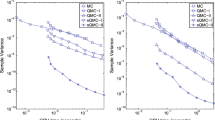Abstract
This paper extends the fast Fourier transform (FFT) network to interest derivative valuation under the Hull–White model driven by a Lévy process. The classical trinomial tree for the Hull–White model is a widely adopted approach in practice, but fails to accommodate the change in the driving stochastic process. Recent finance research supports the use of a Lévy process to replace Brownian motion in stochastic modeling. The FFT network overcomes the drawback of the trinomial approach but maintains its advantages in super-calibration to the term structure of interest rate and efficient computation to various kinds of interest rate derivatives under Lévy processes. The FFT network only requires knowledge of the characteristic function of the Lévy process driving the interest rate process, but not of the interest rate process itself. The numerical comparison between the closed-form solutions of interest rate caps and swaptions and those from FFT network confirms that the proposed network is accurate and efficient. We also demonstrate its use in pricing Bermudan swaptions and other American-style options. Finally, the FFT network is expanded to accommodate path-dependent variables, and is applied to interest rate target redemption notes and a range of accrual notes.














Similar content being viewed by others
References
Beliaeva, N., Nawalkha, S.: Pricing American interest rate options under the jump-extended constant-elasticity-of-variance short rate models. J. Bank. Finance 36(1), 151–163 (2012)
Chu, C.C., Kwok, Y.K.: Target redemption notes. J. Futures Mark. 27(6), 535–554 (2007)
Dellacherie, C., Meyer, P.A.: Probabilities and Potential. North Holland, Amsterdam (1978)
Eberlein, E., Raible, S.: Term structure models driven by general Lévy processes. Math. Finance 9(1), 31–54 (1999)
Eberlein, E., Kluge, W.: Exact pricing formulae for caps and swaptions in a Lévy term structure model. J. Comput. Finance 9(2), 99–125 (2006)
Glasserman, P., Kou, S.G.: The term structure of simple forward rates with jump risk. Math. Finance 14(3), 383–410 (2003)
Glasserman, P., Merener, N.: Numerical solution of jump-diffusion Libor market models. Finance Stoch. 7, 1–27 (2003a)
Glasserman, P., Merener, N.: Cap and swaption approximations in Libor market models with jumps. J. Comput. Finance 7, 1–36 (2003)
Hainaut, D., MacGilchrist, R.: An interest rate tree driven by a Lévy process. J. Deriv. 18(2), 33–45 (2010)
Hull, J., White, A.: Pricing interest-rate derivative securities. Rev. Financial Stud. 3(4), 573–592 (1990)
Jaimungal, S., Surkov, V.: Valuing early-exercised interest rate options with multi-factor affine models. Int. J. Theor. Appl. Finance 16, 1350034 (2013)
Jamshidian, F.: An exact bond option pricing formula. J. Finance 44, 205–209 (1989)
Jacod, J., Shiryaev, A.N.: Limit Theorems for Stochastic Processes. Springer, Berlin (1987)
Kuan, G.C.H., Webber, N.: Pricing barrier options with one-factor interest rate models. J. Deriv. 10, 33–50 (2003)
Lekkos, I.: Distributional properties of spot and forward interest rates: USD, DEM, GBP, and JPY. J. Fixed Income 8, 35–54 (1999)
Raible, S.: Lévy Processes in Finance: Theory, Numerics, and Empirical Facts. Ph.D. dissertation, University of Freiburg (2000)
Wong, H.Y., Guan, Q.: An FFT-network for Lévy option pricing. J. Bank. Finance 35(4), 988–999 (2011)
Wong, H.Y., Zhao, J.: An artificial boundary method for the Hull-White model of American interest rate derivatives. Appl. Math. Comput. 217(9), 4627–4643 (2011)
Wong, T.W., Wong, H.Y.: Valuation of stock loans using exponential phase-type Levy models. Appl. Math. Comput. 222(1), 275–289 (2013)
Acknowledgements
We thank two anonymous referees and the Guest Editor of this special issue for their comments that improve the quality and readability of the paper. MC Chiu acknowledges the supports by Research Grants Council of Hong Kong with Project Numbers: ECS809913 and GRF18200114. HY Wong acknowledges a direct grant of the Chinese University of Hong Kong.
Author information
Authors and Affiliations
Corresponding author
About this article
Cite this article
Chiu, M.C., Xu, Z. & Wong, H.Y. FFT network for interest rate derivatives with Lévy processes. Japan J. Indust. Appl. Math. 34, 675–710 (2017). https://doi.org/10.1007/s13160-017-0259-7
Received:
Revised:
Published:
Issue Date:
DOI: https://doi.org/10.1007/s13160-017-0259-7




